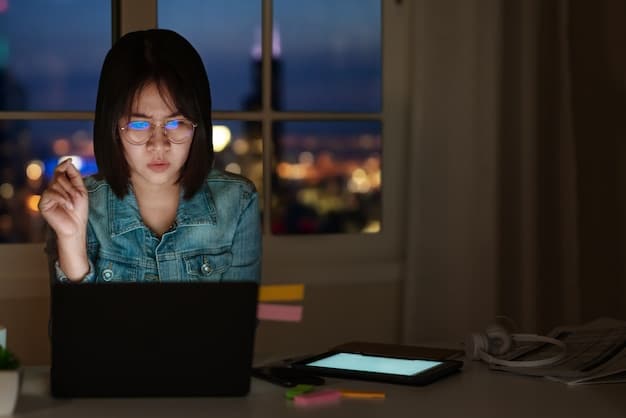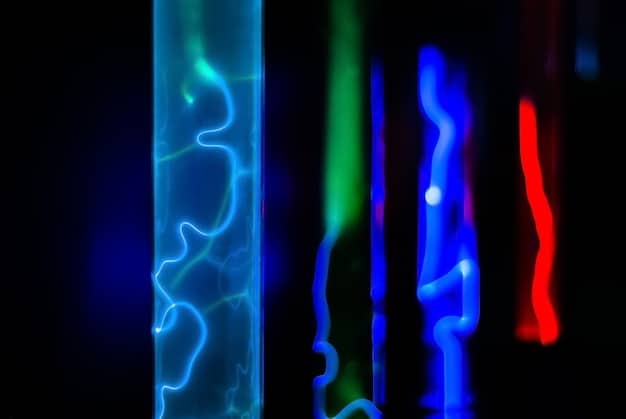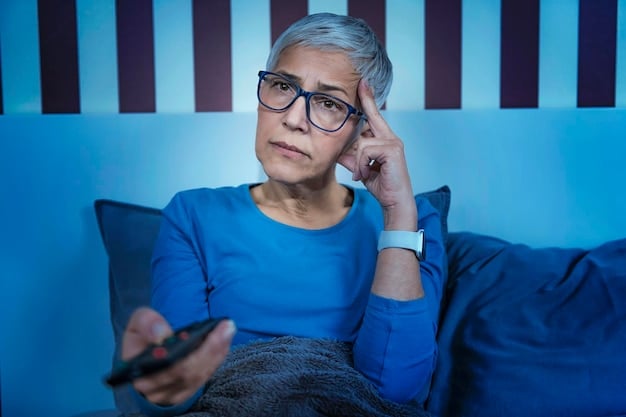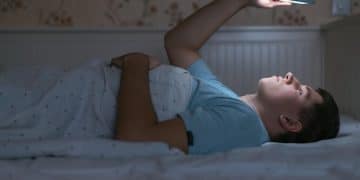The Impact of Blue Light on Eyes and Sleep: 2025 Solutions

The Impact of Blue Light on Your Eyes and Sleep: Practical Solutions for 2025 involves understanding how blue light emitted from screens affects your vision and sleep patterns, and implementing strategies like blue light glasses, screen filters, and optimized sleep hygiene to mitigate these effects.
The pervasive glow of screens is an undeniable part of modern life, but the impact of blue light on our eyes and sleep is a growing concern. The Impact of Blue Light on Your Eyes and Sleep: Practical Solutions for 2025 is about proactively protecting your well-being in an increasingly digital world.
Understanding Blue Light: What It Is and Where It Comes From
Blue light is a high-energy, short-wavelength light that’s part of the visible light spectrum. While it’s naturally present in sunlight, it’s also emitted by digital screens and energy-efficient lighting. This widespread exposure raises concerns about its potential effects on our health.
Our primary sources of blue light exposure today come from:
- Digital devices such as smartphones, tablets, and laptops
- LED and fluorescent lighting
- The sun
Understanding these sources helps us to assess our overall exposure to blue light and take appropriate measures to mitigate its effects.

It’s essential to distinguish between natural and artificial blue light. Natural blue light from the sun helps regulate our circadian rhythm and boosts alertness. However, prolonged exposure to artificial blue light, especially in the evening, can disrupt our internal clock and negatively affect sleep.
In this section, we’ve explored the nature of blue light and its common sources. Recognizing the pervasive nature of blue light is the first step in understanding its potential impact on our health and devising practical solutions for 2025.
The Impact of Blue Light on Your Eyes: Short-Term and Long-Term Effects
The constant bombardment of blue light from screens can have both immediate and lasting effects on our eyes. From temporary discomfort to potential long-term damage, understanding these impacts is crucial for proactive eye care.
Short-term effects of blue light exposure on the eyes include:
- Digital eye strain, characterized by dry eyes, blurred vision, and headaches
- Discomfort and irritation
- Difficulty focusing
These symptoms can significantly impact daily productivity and overall comfort.
Long-Term Effects of Blue Light on Eye Health
While more research is needed, some studies suggest that long-term exposure to blue light may contribute to:
- Age-related macular degeneration (AMD), a leading cause of vision loss
- Cataracts
- Other retinal damage
Protecting our eyes from excessive blue light exposure is therefore a proactive step towards maintaining long-term vision health.
Our eyes are not designed to filter blue light effectively. Nearly all visible blue light passes through the cornea and lens to reach the retina. This can damage light-sensitive cells in the retina, which can lead to vision changes. In this section, we shed light on the potential short-term and long-term consequences of blue light exposure on our eyes. By understanding these effects, we can take necessary precautions to protect our vision.
Blue Light’s Impact on Sleep: Disrupting Your Circadian Rhythm
Beyond its effects on our eyes, blue light significantly impacts our sleep patterns by interfering with our circadian rhythm. Understanding this disruption is vital in optimizing our sleep hygiene for a better night’s rest.
The circadian rhythm is our body’s internal clock that regulates sleep-wake cycles. Blue light interferes with this process by:
- Suppressing the production of melatonin, a hormone that promotes sleep
- Increasing alertness and delaying the onset of sleep
- Making it harder to fall asleep and stay asleep
These disruptions can result in chronic sleep deprivation, impacting overall health and well-being.
To mitigate the sleep-disrupting effects of blue light, consider limiting screen time before bed, using blue light filters, and optimizing your sleep environment for darkness and relaxation.
Blue Light and Melatonin Production
A key consideration is melatonin, which is produced when it’s dark, helping us relax and get ready for sleep. However, when we’re exposed to blue light in the evening, the following occurs:
- Melatonin production is suppressed, making it harder to fall asleep naturally
- Our sleep cycle can be delayed by several hours
- We can experience decreased sleep quality and overall sleep time
These factors contribute greatly to the development of sleep disorders and related health issues.
In summary, blue light disrupts sleep by suppressing melatonin production and interfering with our circadian rhythm. By understanding this impact, we can take practical steps to optimize our sleep hygiene and protect our overall health.
Practical Solutions: Blue Light Blocking Glasses and Screen Filters
Given the potential harm blue light poses to our eyes and sleep, it’s essential to consider practical solutions like blue light blocking glasses and screen filters. These tools can make a significant difference in mitigating blue light exposure from digital devices.
Blue light blocking glasses are designed to:
- Filter out a portion of blue light
- Reduce eye strain
- Improve sleep quality
These glasses come in various styles and filter strengths, allowing users to customize their experience based on their needs.

Screen Filters: An Effective Alternative
Screen filters are another practical solution to reduce blue light exposure. These filters can be installed on:
- Smartphones
- Tablets
- Laptops
They work by blocking or reducing the amount of blue light emitted from the screen.
Both blue light blocking glasses and screen filters can be valuable tools in protecting our eyes and sleep from the harmful effects of blue light. Choosing the right solution depends on individual needs and preferences.
Optimizing Your Environment: Lighting and Sleep Hygiene
Beyond using blue light blocking glasses and screen filters, optimizing your environment is crucial in minimizing blue light exposure and promoting healthy sleep hygiene. This involves making strategic adjustments to your lighting and overall sleep environment.
When it comes to lighting, several key steps can be taken:
- Use warm-toned, low-intensity lights, especially in the evening
- Avoid bright, cool-toned LED lights that emit high levels of blue light
- Employ dimmer switches to control the intensity of lighting
These measures can significantly reduce your exposure to artificial blue light and support healthy sleep patterns.
Improving Sleep Hygiene For Better Rest
To enhance your sleep environment, implement the following practices:
- Create a dark, quiet, and cool room
- Use blackout curtains to block external light
- Establish a consistent sleep schedule
- Avoid caffeine and alcohol before bed
These practices promote relaxation and improve the quality of your sleep.
By optimizing your lighting and sleep environment, you can create a sanctuary that supports restful sleep and minimizes the negative effects of blue light. This holistic approach complements the use of blue light blocking glasses and screen filters for a comprehensive strategy.
Future Trends: 2025 and Beyond in Blue Light Mitigation
As technology continues to evolve, so will our strategies for mitigating the impact of blue light. The year 2025 and beyond hold exciting possibilities for innovative solutions that can further protect our eyes and sleep.
Future trends in blue light mitigation may include:
- Advanced eye-care technologies
- Smart lighting systems
- Personalized blue light management
These advancements promise to offer more effective and convenient ways to manage our blue light exposure.
Emerging Technologies in Eye Care
Several emerging technologies will be developed to help mitigate the effects of blue light on our eyes:
- Next-generation blue light blocking lenses
- Adaptive screen technology that dynamically adjusts blue light emissions based on ambient lighting
- Innovative eye drops designed to protect the retina
These advancements represent a significant step forward in eye care.
As we look ahead to 2025 and beyond, it’s clear that blue light mitigation will remain a priority. With ongoing research and technological advancements, we can expect even more effective and user-friendly solutions to protect our eyes and sleep in an increasingly digital world.
| Key Point | Brief Description |
|---|---|
| 💡 Blue Light Sources | Devices, LEDs, and sunlight emit blue light. |
| 😴 Sleep Disruption | Blue light suppresses melatonin, disrupts sleep. |
| 👓 Blocking Tools | Glasses and filters reduce blue light exposure. |
| 🌙 Sleep Hygiene | Optimize room lighting and sleep environment. |
FAQ
▼
What are the main sources of blue light?
▼
Blue light is a high-energy, short-wavelength light in the visible spectrum. It is emitted by the sun, digital screens, and energy-efficient lighting.
▼
Does blue light effect my sleep?
▼
Blue light suppresses melatonin production, disrupting your circadian rhythm and making it harder to fall asleep and stay asleep.
▼
Are blue light blocking glasses useful?
▼
Yes, blue light blocking glasses can help reduce eye strain and improve sleep quality by filtering out a portion of blue light.
▼
How can I protect myself from blue light?
▼
Use screen filters on digital devices, optimize your environment with warm-toned lights, and practice good sleep hygiene to minimize exposure.
▼
What might help with blue light in the future?
▼
Emerging technologies may include advanced eye-care, smart lighting systems, and personalized blue light management solutions for better protection.
Conclusion
In conclusion, understanding and mitigating the impact of blue light on our eyes and sleep is essential for maintaining overall well-being in our increasingly digital world. By adopting practical solutions such as blue light blocking glasses, screen filters, optimized lighting, and improved sleep hygiene, we can proactively protect our health and enjoy better quality of life in 2025 and beyond.





